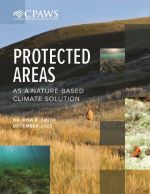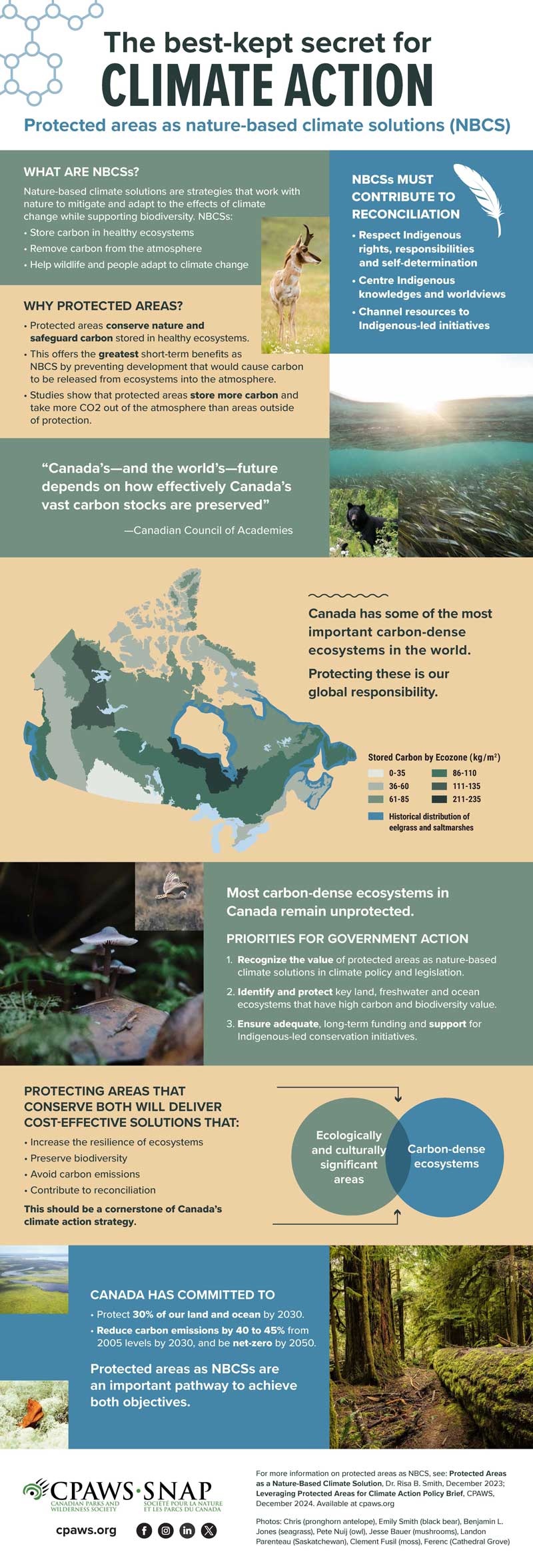Protected Areas as a Nature-based Climate Solution by Dr. Risa B. Smith (2023) – This report delves into the science behind using protected areas for climate action.
Leveraging Protected Areas for Climate Action Policy Brief (2024) – In this brief, CPAWS presents several policy recommendations, based on Dr. Smith’s report, that will help Canada to harness the power of protected areas to meet its climate goals.
Read the blog post.
Biodiversity
A term that encompasses all living things on the planet, including humans, other animals, plants and species that are too small to be seen by the human eye.
Nature-Based Climate Solutions
Nature-based solutions are “solutions to societal challenges that involve working with nature” to provide benefits for both human well-being and biodiversity. Nature-based climate solutions (NBCS) are a subset of nature-based solutions that specifically address climate change mitigation and adaptation and at the same time provide multiple benefits for biodiversity and people. NBCS include many actions such as protection, restoration and better management of living resources. However, consensus is emerging that effectively designed and managed protected areas offer the highest total per hectare value as a NBCS.
Check out our infographic about
Protected Areas as Nature-Based Climate Solutions in Canada
Climate change in Canada:
Humans are facing dual crises: unprecedented biodiversity loss and catastrophic impacts due to climate change. Nearly a million species face extinction, primarily due to habitat loss, overexploitation, and a changing climate. Greenhouse gas emissions have soared to levels not witnessed in the past 800,000 years, resulting in a rapid rise in global temperatures. This surge has led to intensified heatwaves, severe storms, and rising sea levels that are impacting communities worldwide. Each crisis exacerbates the other, with climate change causing populations and entire species to go extinct, and the loss of biodiversity making ecosystems more vulnerable to climate change.
Join the movement to take action to protect 30% of land and ocean by 2030.
The Intergovernmental Panel on Climate Change (IPCC) estimates that a 1.5° C increase in the global average temperature will put 20-30% of the world’s species at risk of extinction. Canada has already experienced a 1.7° C increase in temperature since 1948—twice the global average. We must significantly reduce our greenhouse gas emissions in order to prevent a further increase in temperature and avoid the environmental changes that would come with it.
Canada is home to some of the most carbon-dense ecosystems in the world. Remaining primary boreal and temperate forests, northern peatlands, ancient grasslands, and coastal marine ecosystems can make a significant contribution to attaining GHG emissions targets. Canada’s carbon-dense ecosystems are currently poorly represented in its protected areas.
Canadian governments at all levels have pledged to both reduce the GHG emissions causing climate change and to step-up measures to protect biodiversity. If the federal government meets its commitment under the Paris Agreement to reduce GHG emissions to 30% below 2005 levels by 2030, Canada’s ecosystems will experience greater stability and better support biodiversity. Nature-based solutions will be an important part of the process. Canada must prioritize protection for ecologically and culturally significant areas that overlap with carbon-dense ecosystems like the boreal forest, wetlands, grasslands, peatlands and eelgrass.
Well-designed and effectively and equitably managed protected areas are scientifically proven to be effective in conserving nature and offer the highest total per hectare benefit as a nature-based climate solution (NBCS).
Implementation of nature-based climate solutions should be conducted in recognition of rights and title of Indigenous lands, respect for Indigenous knowledge, and with assurances that Indigenous People lead on land-use decisions on their territories.
Protected areas serve as a crucial nature-based climate solution by preserving ecosystems’ natural ability to sequester carbon dioxide from the atmosphere. By managing these areas and preventing their conversion to other uses, they contribute significantly to reducing greenhouse gas emissions.
Protected areas, including forests, grasslands, wetlands, and marine environments have substantial potential to sequester and store carbon dioxide. Scientists estimate that safeguarding such areas could result in significant reductions in global emissions. For example:
• Protecting 900 km2 per year of old-growth forests in Canada from 2021-2030 would sequester equal to 5 to 6% of emissions reductions that Canada has committed to;
• Protecting the remaining native Prairie grasslands in Canada (12,700 km2) would sequester the equivalent of 0.7 to 0.8% of emissions reductions that Canada has committed to and protect two to three gigaton of carbon that is stored in these ancient grasslands, from release into the atmosphere;
• The Hudson Bay Lowlands, the second largest intact peatland area in the world, sequestered the equivalent of 11% of Canada’s total emissions in 2020, and prevented the release of the 30 Gigaton of carbon that is stored.
Protecting carbon-rich ecosystems within Canada, such as northern peatland complexes in the Hudson Bay Lowlands and the Mackenzie River Basin; old-growth boreal and temperate forests; coastal blue carbon systems including remaining eelgrass meadows and salt marshes on all three coasts, and ancient prairie grasslands, would contribute directly to the country’s emission reduction commitments. The preservation of these areas would ensure that carbon is stored, and that its prevented from being released into the atmosphere.
Resources

2023: Protected Areas as a Nature-Based Climate Solution
by Dr. Risa B. Smith
2020 – Forests for Life: Recovery for Forestry, Climate, and Nature
2019 – Finding Common Ground: Six steps for tackling climate change and biodiversity loss in Canada
2019 – CPAWS’ Recommendation for a Nature-Based Climate Fund
2016 – CPAWS’ Nature-Focused Solutions to Climate Change
2013 – Canadian Parks and Protected Areas: Helping Canada Weather Climate Change
2009 – CPAWS’ Public Forest Carbon Briefing Notes
2008 – CAN International Discussion Paper on LULUCF Issues and Considerations
2008 – CPAWS’ Letter in Support of the Western Climate Initiative
2007 – Wilderness Conservation and Climate Change: What’s the Connection?


